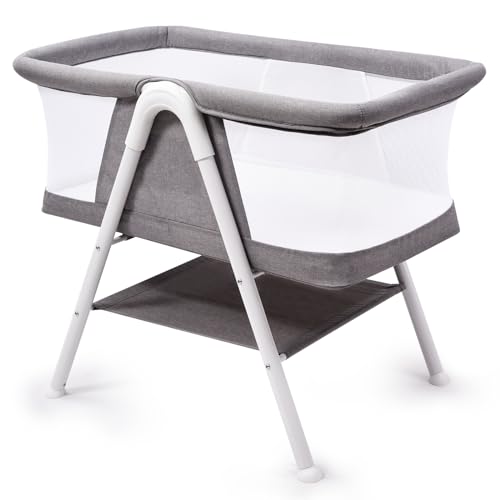Who Is The World's Top Expert On Bedside Crib For Attachment Parenting?
The Benefits of Bedside Cribs for Attachment Parenting
Attachment parenting is a child-rearing approach that stresses the importance of forming a strong emotional bond between a moms and dad and kid. One of the crucial parts of this method is co-sleeping, which promotes close physical proximity in between parents and their infants. Bedside cribs have gained substantial popularity as a useful and safe sleeping option that allows parents to practice attachment parenting successfully. This short article looks into the benefits of bedside cribs, their features, and crucial considerations for parents.
What is a Bedside Crib?
A bedside crib, also known as a sidecar crib, is a kind of infant sleeping plan that attaches securely to the side of a parent's bed. This design enables the baby to oversleep their own separate space while keeping easy access for feeding, comforting, and monitoring. Bedside cribs are available in different styles, from simple mesh styles to wooden cribs that match the design of the parents' bedroom.
Secret Features of Bedside Cribs
When thinking about a bedside crib, it's necessary to examine its features to ensure it fits the needs of both moms and dad and baby. Here are some crucial characteristics to look out for:
Feature
Description
Adjustable Height
Many bedside cribs have adjustable height settings to align with the parent's bed mattress.
Side Panel Access
A side panel that can be decreased enables easy access to the baby throughout the night.
Durable Construction
Premium products, such as solid wood or durable metal frames, offer stability and security.
Safety Features
Search for cribs with safety accreditations and functions such as safe locking systems.
Breathable Materials
Bedside cribs typically use breathable materials to promote air circulation, minimizing the threat of suffocation.
Benefits of Bedside Cribs for Attachment Parenting
1. Promotes Bonding
Bedside cribs facilitate a nurturing environment where infants can sense their parents' presence, which promotes emotional security and attachment. The close distance assists parents react more promptly to their baby's needs during sleep, promoting a sense of security and trust.
2. Alleviate of Feeding
For breastfeeding moms, bedside cribs provide exceptional convenience for nighttime feeding. Baby Co Sleeper Crib can quickly reach their baby without rising, making late-night feedings less disruptive for both moms and dad and kid.
3. Reduces Risks Associated with Co-Sleeping
While co-sleeping can promote attachment, it also brings threats such as suffocation and falling. Bedside cribs offer a compromise, supplying a safe sleeping space for the baby while still allowing parents to sleep close by.
4. Much Better Sleep for Parents
Given that parents can address their baby's requirements without completely waking or leaving the bed, they can maintain much better sleep quality. This is especially essential throughout the early months when sleep deprivation can take a toll on parental health.
5. Increased Convenience
With a bedside crib, parents can easily monitor their baby's movements and listen for any nighttime fussing, allowing for quicker interventions when required. This benefit is particularly advantageous for parents requiring to handle their time successfully.
Selecting the Right Bedside Crib
When picking a bedside crib that aligns with the concepts of attachment parenting, parents should consider several elements:
- Safety Standards: Always select a crib that fulfills safety regulations and standards to ensure the infant's well-being.
- Size Compatibility: Ensure the crib fits firmly beside the moms and dad's bed and can be adjusted for height.
- Reduce of Access: Look for features that permit easy side access, particularly advantageous for breastfeeding.
- Portability: If travel is part of household life, think about a crib that is light-weight and easily portable.
- Budget: Bedside cribs come in a variety of cost varieties. There are numerous inexpensive alternatives that do not jeopardize on security or quality.
Often Asked Questions (FAQs)
Q1: Are bedside cribs safe for newborns?A1: Yes, bedside cribs are designed with safety features to guarantee a safe sleeping environment for newborns. Always follow the maker's standards and security standards. Q2: Will my baby outgrow a bedside
crib quickly?A2: It depends upon the design. Many bedside cribs can accommodate
infants as much as 6-12 months, but it's crucial to check the weight and height limitations defined by the manufacturer. Q3: Can I use a bedside crib if I have a smaller sized bed?A3: Yes, lots of bedside cribs are adjustable and
can be lined up with different bed sizes. Constantly make sure the attachment is secure. Q4: How does a bedside crib differ from co-sleeping? A4: Co-sleeping involves sharing the very same sleep surface area
, while bedside cribs provide a separate sleeping
space for the baby, keeping security and promoting attachment. Q5: Can I use a bedside crib if I'm not breastfeeding?A5: Absolutely! Bedside cribs are useful for all parents and caretakers, making it easier
to comfort and address a baby, regardless of feeding methods. Bedside cribs represent an indispensable tool for parents who embrace attachment parenting. They not just enable physical closeness however likewise improve safety and convenience during the newborn stage. Parents should thoroughly choose a bedside crib that abides by security standards and fits their lifestyle, guaranteeing a nurturing environment for both baby and parent. By promoting bonding, ease of feeding, and better sleep for parents, bedside cribs play a significant function in promoting the principles of attachment parenting— a gratifying journey that nurtures a stronger, caring connection between parents and their children. 